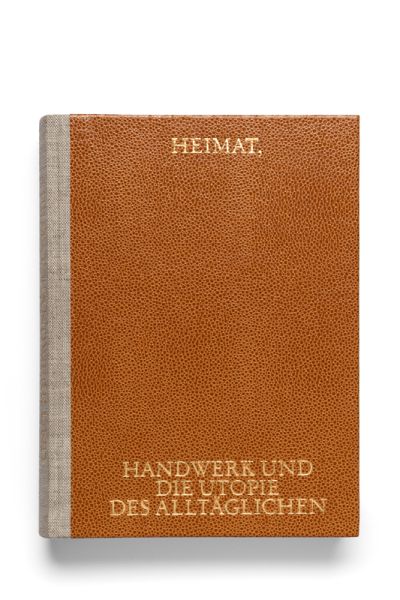Uta Hassler
HEIMAT, HANDWERK UND DIE UTOPIE DES ALLTÄGLICHEN
- category
- Goldene Letter
jury statement
★★★★★
Switzerland /// Schweiz
★★★★★
The cover – which is not even remotely everyday – gives this book the appearance of a cornerstone on an architecture library shelf. This weighty work was designed as a half-bound volume. A coarse linen fabric protects the wide spine. An exotic effect is produced by the structures of the board covers: at the front, tobacco-coloured ray skin; at the back, lightly shimmering lizard skin. A dusky pink headband seals up the gap between the gilded top edge and the inner spine. The golden capital letters used for the embossed title are positioned unusually near the upper and lower edges. This study on the concept of the homeland in architecture and landscape design during the first half of the 20th century consists of critical essays documented with historical texts and pictures. The observer wonders if the elaborate outfit glorifies the notion of the homeland. The basic text reposes in a traditional type area, splendidly typeset with wide gutters. However, the solemn mood is counteracted by typographic jibes: paragraphs begin with large indents; illustration details are placed on the left-hand side next to the column and leave a gap where they were taken out of the body text; pagination is always on the right-hand side (therefore deep in the gutter margin on the left page); captions stretch across the entire width along the top edge, but in silver printing. The headlines on the centreline are all in firm contrast. The typographical irony does not invalidate the seriousness of this analysis, but rather underlines the critical distance. This is the subtle achievement of this book.
★★★★★
Der keineswegs alltägliche Einband lässt dieses Buch wie einen Meilenstein im Regal einer Architekturbibliothek erscheinen. Die schwerwiegende Studie wurde als Halbband ausgebildet. Ein grobes Leinwandgewebe schützt den breiten Rücken. Für einen exotischen Effekt sind die Strukturen der Deckelbezüge verantwortlich: vorne tabakfarbene Rochenhaut, hinten hell schimmernde Echsenhaut. Altrosafarbenes Kapitalband dichtet die Fuge zwischen Kopfschnittvergoldung und innerem Rücken ab. Die goldenen Versalzeilen der Titelprägung sind ungewöhnlich weit nach oben und unten geschoben. Die Studie über den Heimatgedanken in Architektur und Landschaftsgestaltung der ersten Hälfte des 20. Jahrhunderts besteht aus kritischen Aufsätzen, unterfüttert mit historischen Texten und Bildern. Man fragt sich, ob die aufwendige Ausstattung den Heimatbegriff glorifiziert. Der Grundtext ruht in einem traditionellen Satzspiegel, splendid gesetzt, mit breiten Stegen. Doch die gravitätische Anmutung wird mit typografischen Sticheleien konterkariert: Absätze beginnen mit weiten Einzügen; Abbildungshinweise stehen links neben der Kolumne und hinterlassen dort, wo sie aus dem Fließtext herausgenommen wurden, eine Lücke; Paginierung immer rechts (linksseitig also tief im Bundsteg); Bildlegenden auf voller Formatbreite im Kopfsteg, jedoch in silberfarbenem Druck. Die Überschriften auf Mittelachse stehen fest geschlossen dagegen. Die typografische Ironie setzt die Ernsthaftigkeit der Auseinandersetzung nicht außer Kraft, unterstreicht vielmehr die kritische Distanz. Das ist die subtile Leistung dieser Buchgestalt.

